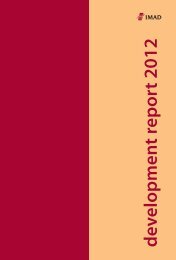You also want an ePaper? Increase the reach of your titles
YUMPU automatically turns print PDFs into web optimized ePapers that Google loves.
IB Revija 1-2/<strong>2011</strong><br />
63<br />
judgement alone. In addition to policy makers, decisionmakers<br />
in companies are interested in economic<br />
forecasts, as well as assessments of the quantitative<br />
impacts of international economic events on the<br />
domestic economy. A macroeconometric model such<br />
as SLOPOL that represents the most important markets<br />
of the Slovenian economy and that is based on sound<br />
economic theory and on actual data is a useful tool for<br />
these tasks, i.e. forecasting and simulation. Simulations<br />
of the model (both static and dynamic) with historical<br />
values of exogenous variables over the period of<br />
estimation gave rise to a reasonable tracking quality<br />
for most variables with respect to trends and turning<br />
points. This may be seen as an encouragement to use<br />
the model for policy analysis. Nevertheless, it should be<br />
mentioned that the SLOPOL model is – as with every<br />
structural econometric model – subject to the Lucas<br />
critique.<br />
A forecast that was generated with the model was in<br />
line with official forecasts created with other methods. It<br />
points to a gradual recovery of the Slovenian economy<br />
after the severe recession observed in 2009.<br />
References:<br />
Brown, R.L., Durbin, J. and Evans, J.M. (1975). Techniques<br />
for testing the constancy of regression relationships<br />
over time, Journal of the Royal Statistical Society, Series<br />
B, 37, 149–192.<br />
Chow, G.C. (1960). Test of equality between sets of<br />
coefficients in two linear regressions, Econometrica, 28,<br />
591–605.<br />
Engle, R.F., Hendry, D.F. and Richard, J.F. (1983).<br />
Exogeneity. Econometrica, 51, 277–304.<br />
Ericsson, N.R. (1992). Cointegration, exogeneity and<br />
policy analysis, Journal of Policy Modelling, 14(3), 251–<br />
280.<br />
Neck, R., Weyerstrass, K. and Haber, G. (2004). Policy<br />
Recommendations for Slovenia: A Quantitative<br />
Economic Policy Approach. In: B. Boehm, H. Frisch, M.<br />
Steiner (eds.), Slovenia and Austria: Bilateral Economic<br />
Effects of Slovenian EU Accession, Graz, 249–271.<br />
Richard, J.F. (1980). Models with several regimes and<br />
changes in exogeneity, Review of Economic Studies,<br />
47(1), 1–20.<br />
Sargan, J.D. (1964). Wages and Prices in the United<br />
Kingdom. A Study in Econometric Methodology, in:<br />
P.E. Hart, G. Mills and J.K. Whitaker (eds.), Econometric<br />
Analysis for National Economic Planning, 25–59.<br />
Butterworth. London.<br />
Sargent, T. (1981). Interpreting economic time series,<br />
Journal of Political Economy, 89, 213–248.<br />
Weyerstrass, K., and Neck, R. (2008a). Macroeconomic<br />
effects of Slovenia’s integration in the euro-area,<br />
Empirica, Vol. 35, No. 4, 391–403.<br />
Weyerstrass, K. and Neck, R. (2008b). Macroeconomic<br />
consequences of the adoption of the euro: The case of<br />
Slovenia, International Advances in Economic Research,<br />
Vol. 14, 1–10.<br />
Weyerstrass, K. and Neck, R. (2007). SLOPOL6: A<br />
macroeconometric model for Slovenia, International<br />
Business & Economics Research Journal, 6(11), 81–94.<br />
Weyerstrass, K. (2008). Economic policies on Slovenia’s<br />
road to the euro-area, Economic Systems, Vol. 32, No. 1,<br />
92–102.<br />
Weyerstrass, K., Haber, G. and Neck, R. (2001). SLOPOL1:<br />
A macroeconomic model for Slovenia. International<br />
Advances in Economic Research 7 (1), 20–37.<br />
Florens, J.P. and Mouchart, M. (1985). Conditioning in<br />
dynamic models, Journal of Time Series Analysis, 6(1),<br />
15–34.<br />
IMAD (2010). Autumn forecasts of economic trends<br />
2010. Ljubljana.<br />
Lucas, R. (1976). Econometric Policy Evaluation: A<br />
Critique. in: K. Brunner and A. Meltzer (eds.), The<br />
Phillips Curve and Labor Markets, Carnegie-Rochester<br />
Conference Series on Public Policy, 1, New York. American<br />
Elsevier, 19–46.

















